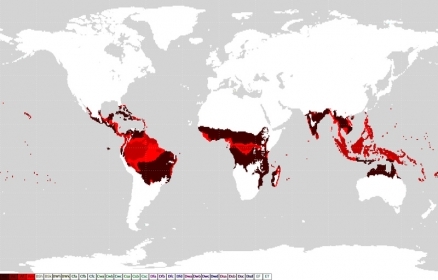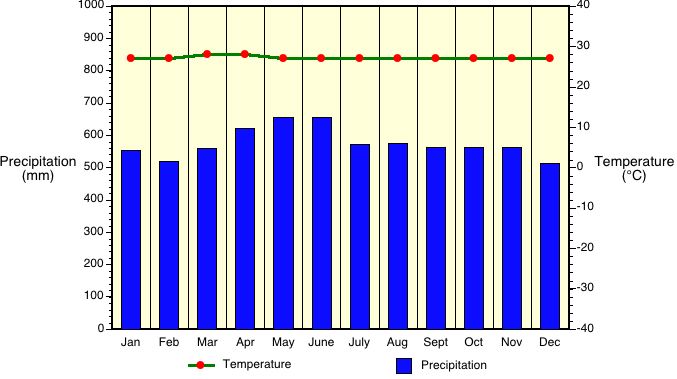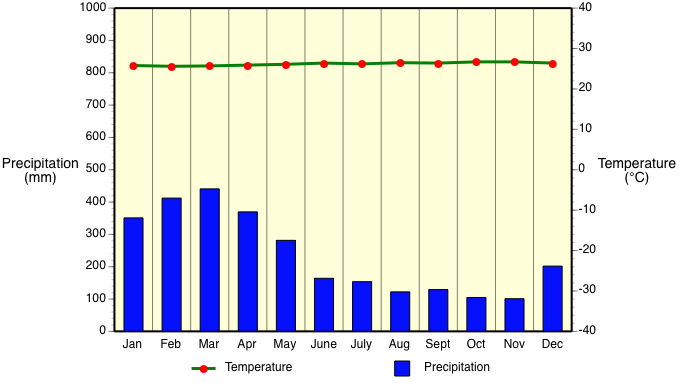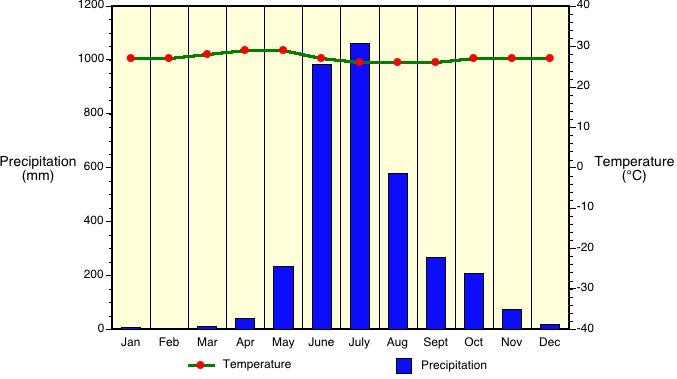Tropical Moist Climates - A Climate Type
| Topics: |
Contents

 Introduction
Introduction
Within the Köppen Climate Classification System, tropical moist climates extend northward and southward from the equator to about 15 to 25° of latitude. In these climates, all months have average temperatures greater than 18° Celsius (64° Fahrenheit). Annual precipitation is often greater than 1500 mm (59 in.).
See link for high reslution Köppen Climate Map to see the spatial distribution of the A climate type.
Three minor Köppen climate types exist in the A group. These three categories of tropical moist climate are distinguished on the seasonal distribution of rainfall.
Af – Tropical Wet
Af or tropical wet is a tropical climate where precipitation occurs all year long. Monthly temperature variations in this climate are usually less than 3°C (37°F). Because of intense surface heating and high humidity, cumulus and cumulonimbus clouds (thunderstorms) form early in the afternoons almost every day. Daily highs are about 32°C (90°F). Radiative cooling during the evening is limited because of cloud cover and high humidity. Nighttime daily temperatures average about 22°C (72°F).
Locations: Amazon River Basin (South America), Congo River Basin (Africa), eastern coast of Central America, eastern coast of Brazil, the Philippines, coast of Madagascar, eastern India, southern Bangladesh, Malaysia, and Indonesia.
Controlling Weather Factors: High year round input of high quantities of solar radiation (insolation). High and constant monthly precipitation because of the presence of thunderstorm activity associated with the Intertropical Convergence Zone.
Climate Characteristics: Constant high temperatures throughout the year. Average monthly temperatures are very similar - yearly range is about 2 to 3°C (36 to 37°F). Monthly precipitation is evenly distributed and annual amounts are usually greater than 1500 mm (59 in.). These climates also have frequent cumulus cloud development with some of these clouds becoming air mass thunderstorms. Humidity tends to be high.
Examples:
Aw – Tropical Wet and Dry
The tropical wet and dry or savanna (Aw) has an extended dry season during winter. Precipitation during the wet season is usually less than 1000 millimeters (39 in.), and only during the summer season. Average monthly temperatures for all months is greater than 18°C (64°F). More than two months have less than 60 mm (2.4 in.) of precipitation. There is a distinct dry season during low-sun period (winter) and a distinct wet season during the high-sun period (summer). These climates are generally pole ward of Af climate areas.
Locations: Northern and eastern India, central Myanmar, the Indo-Chinese Peninsula, northern Australia, region around the Congo River basin, south-central Africa, western Central America, parts of Venezuela, and parts of Brazil, southern tip of Florida, and the Caribbean Islands.
Controlling Weather Factors: alternating wet and dry seasons caused by the seasonal presence of the Intertropical Convergence Zone during the high-sun season and the Subtropical High Pressure Zone during the low-sun season.
Climate Characteristics: Monthly precipitation data shows distinct high-sun wet and low-sun dry seasons. Annual rainfall averages between 750 and 1800 mm (30 and 71 in.). This climate has the highest monthly temperature ranges of the A climate category.
Example:
Am – Tropical Monsoon
Am is a tropical monsoon climate. Annual rainfall is equal to or greater than Af, but most of the precipitation falls in the 7 to 9 hottest months. Have a very pronounced wet season. During the dry season very little rainfall occurs. Average monthly temperatures for all months is greater than 18°C (64° F). Have one or more months with less than 60 mm (2.4 in.) of precipitation.
Locations: Coastal areas of southwestern India, Sri Lanka, Bangladesh, Myanmar, southwestern Africa, Guyana, Surinam, French Guiana, and parts of northeast and southeast Brazil.
Controlling Weather Factors: Monsoonal summer onshore and winter offshore air mass movement related to shifting Intertropical Convergence Zone and changing surface atmospheric pressure conditions over the landmasses and ocean areas involved.
Climate Characteristics: Climate of this category is transitional between Af and Aw. Heaviest rainfall records in world occur in this climate type (Cherripunji, India – 12,000 mm (472 in.)). Heavy rainfall is associated with the high-sun (summer) season. Precipitation is usually enhanced by orographic uplift. Yearly precipitation totals range from between 1500 to 4000 mm. Dry season is associated with low-sun (winter) period. Annual temperature range of monthly averages is about 2 to 6°C (36 to 43°F). Highest monthly temperature often occurs just prior to the start of the rainy season.
Example:
Online Köppen Maps
References
- Aguado, E. and James E. Burt. 2010. Understanding Weather and Climate. Fifth Edition. Prentice Hall, Upper Saddle River, New Jersey.
- Ahrens, C. D. 2006. Meteorology Today. An Introduction to Weather, Climate, and the Environment. Eighth Edition. Thompson, Brooks/Cole. USA.
- Lutgens, F.K. and E.J. Tarbuck. 2004. The Atmosphere: An Introduction to Meteorology. NinthEdition. Prentice Hall, Upper Saddle River, New Jersey.
- Lydolph, P.E. 1985. The Climate of the Earth. Rowman and Allanheld Publishers, Totowa, New Jersey.
- Oliver, J.E. and J.J. Hidore. 2002. Climatology: An Atmospheric Science. Second Edition. Prentice Hall, Upper Saddle River, New Jersey.
- Peel, Murray C. 2011. Updated Köppen-Geiger Climate Map of the World. http://people.eng.unimelb.edu.au/mpeel/koppen.html




